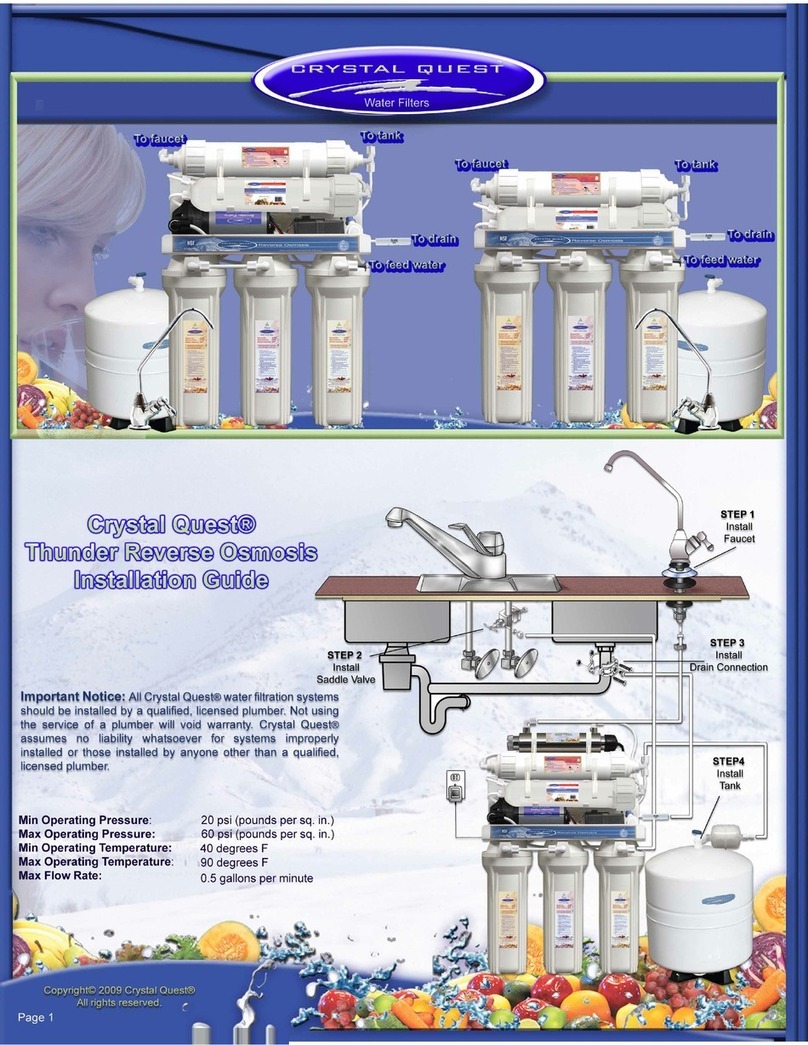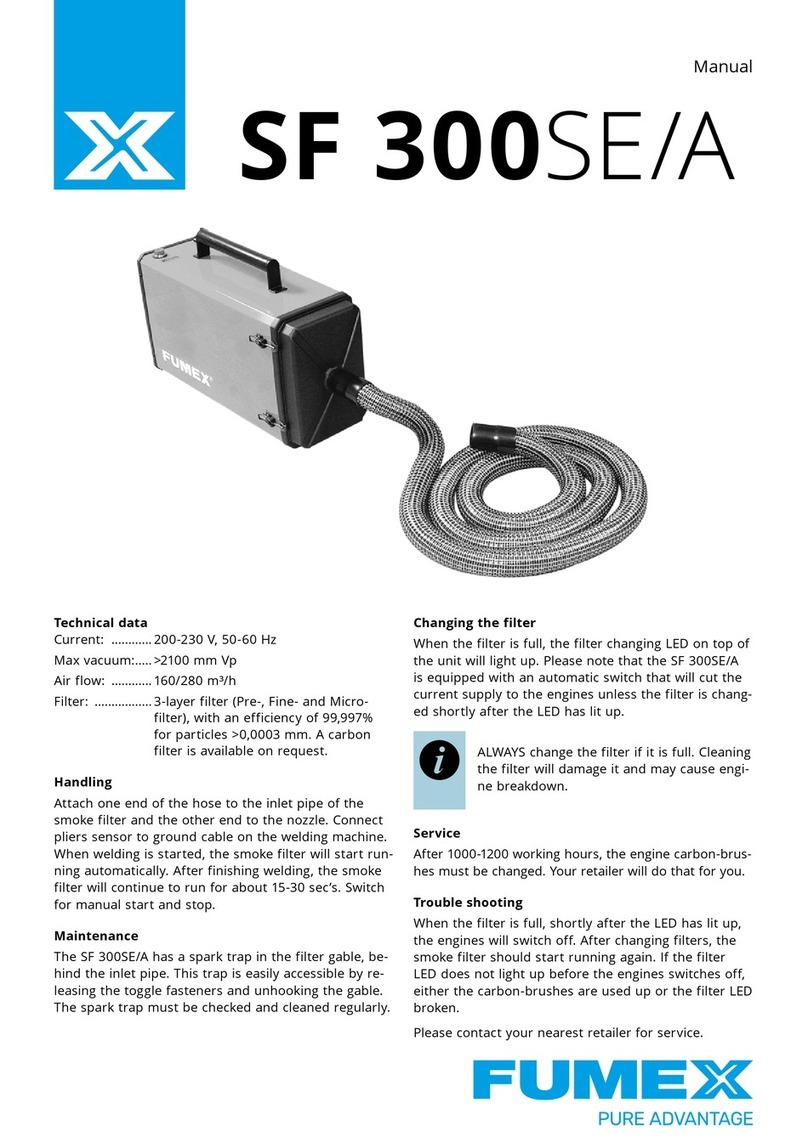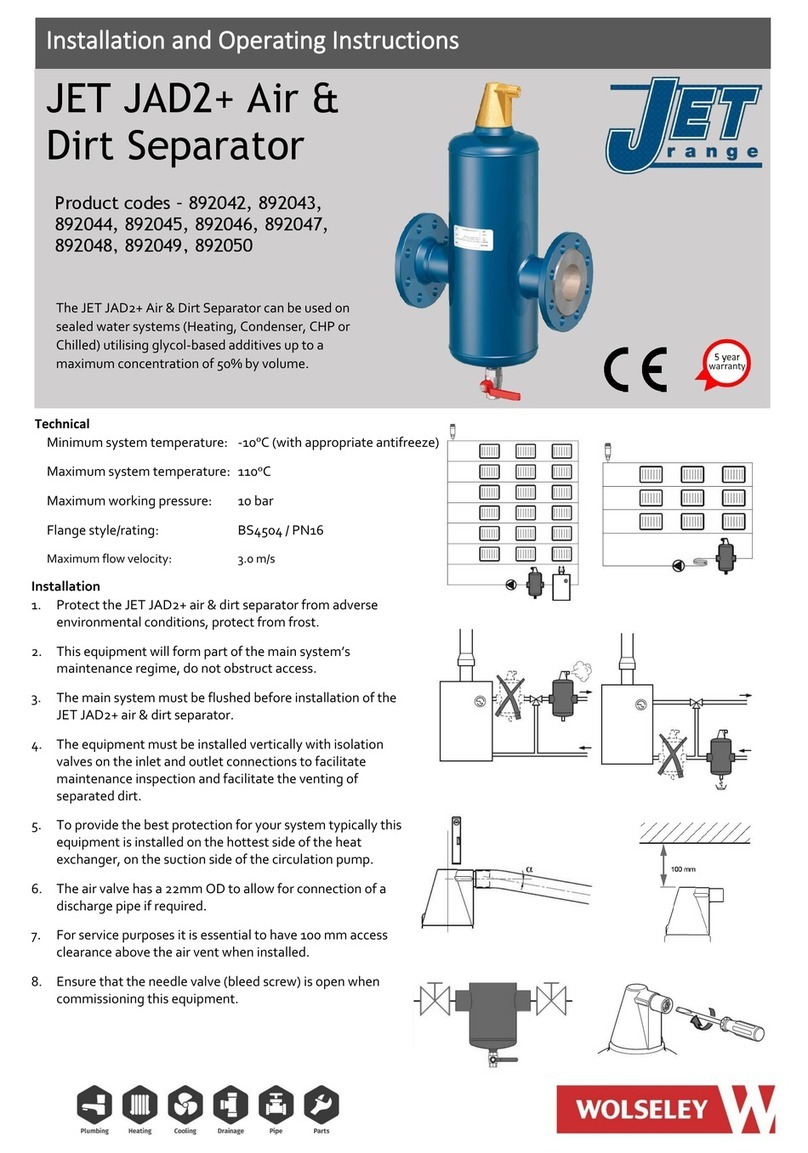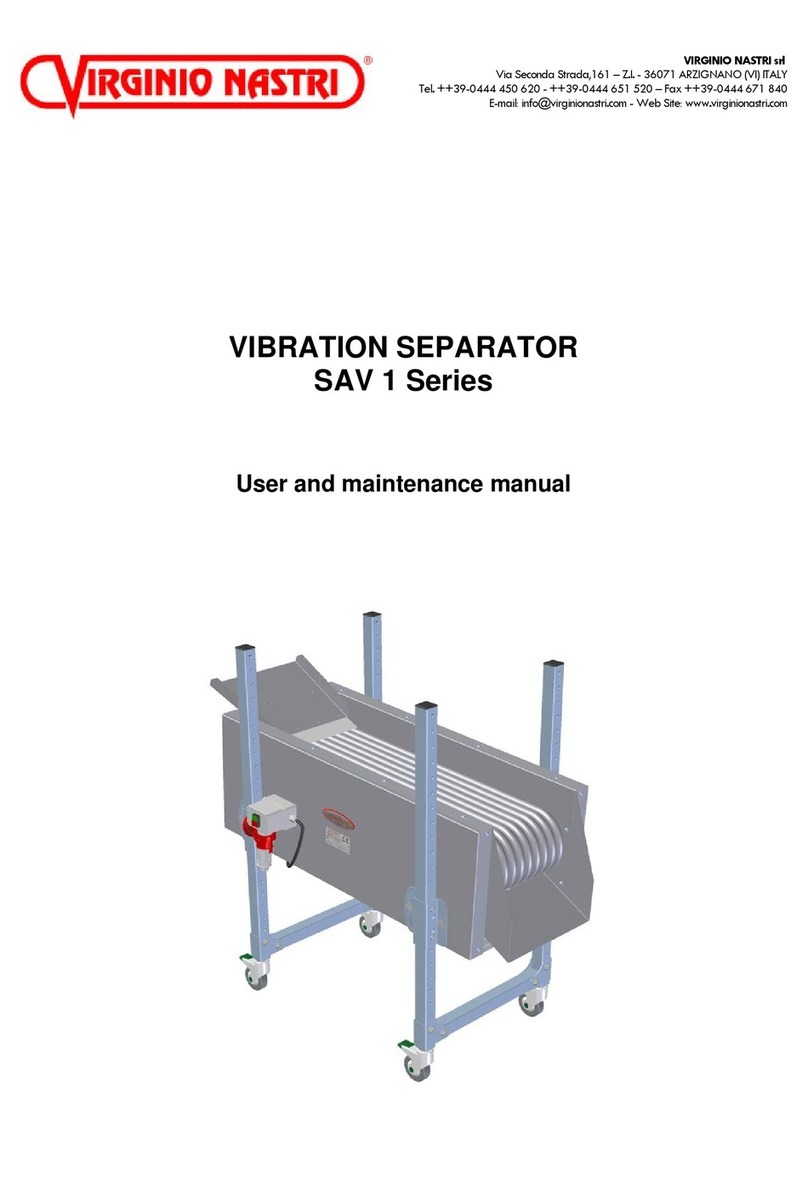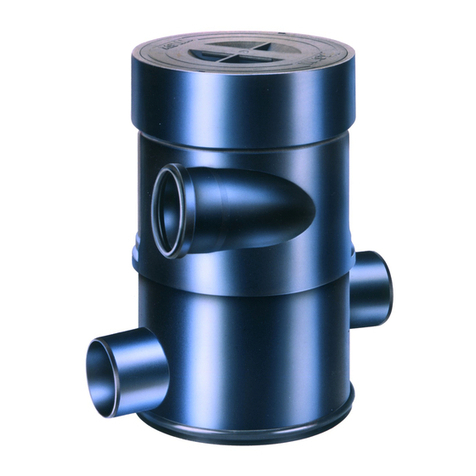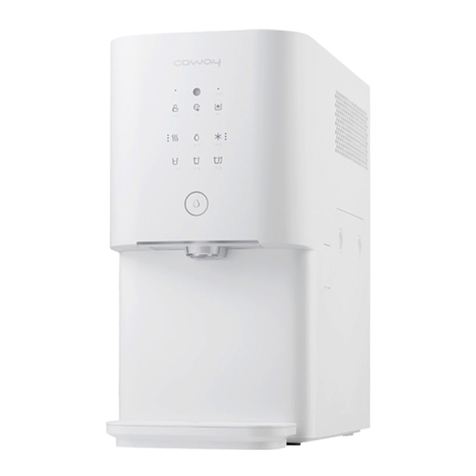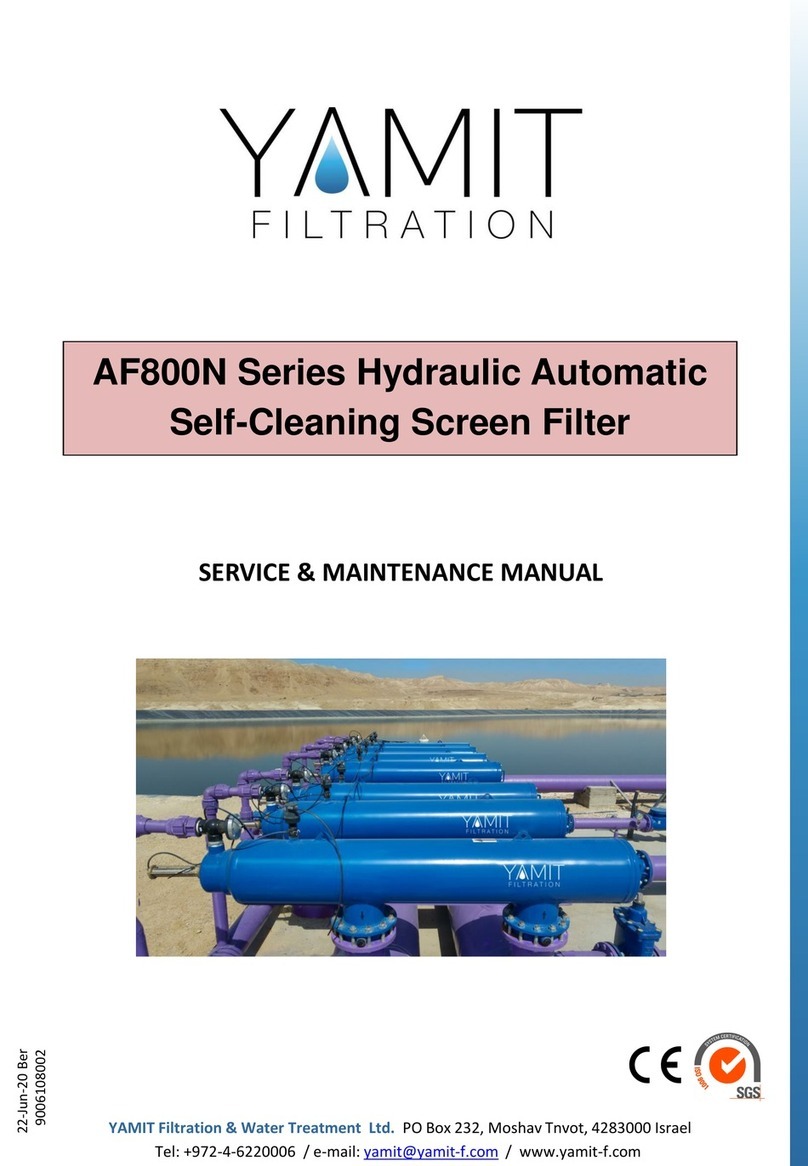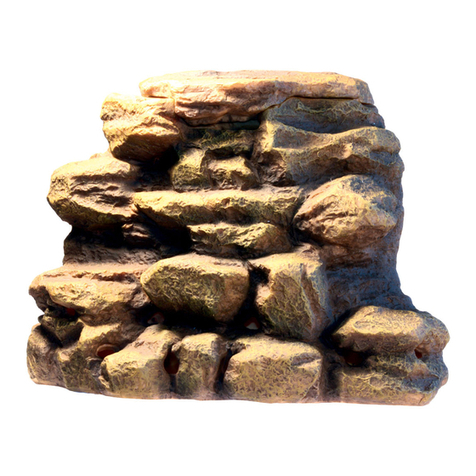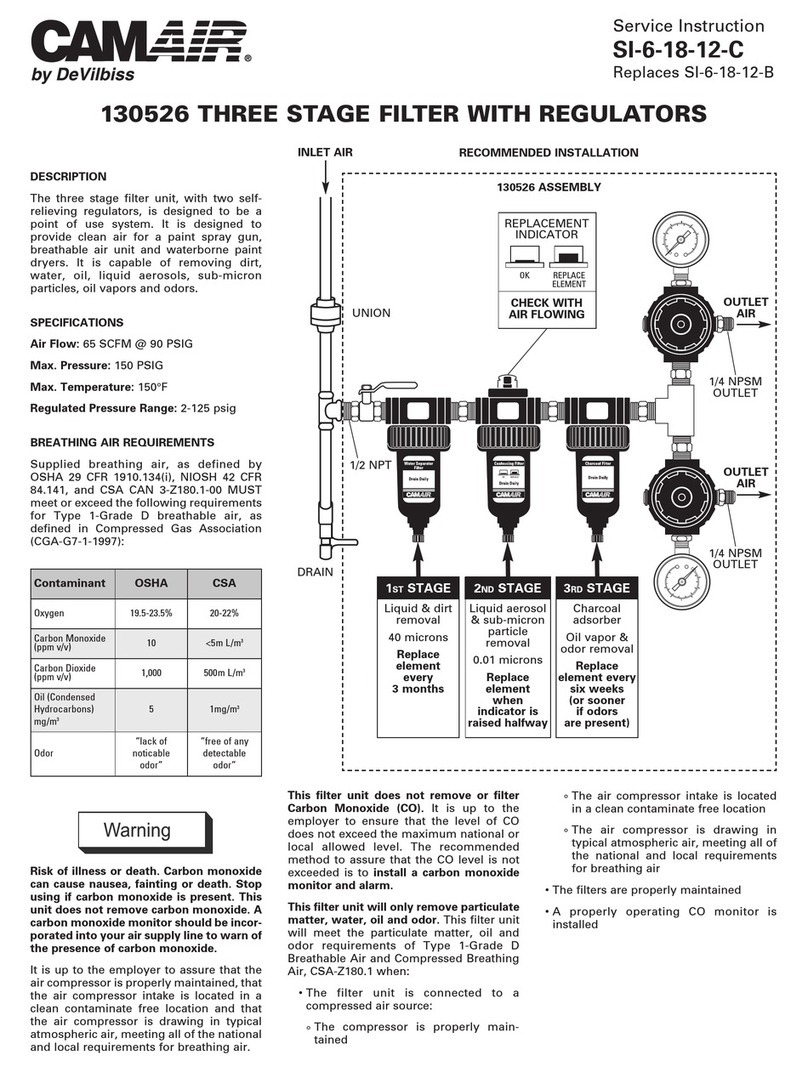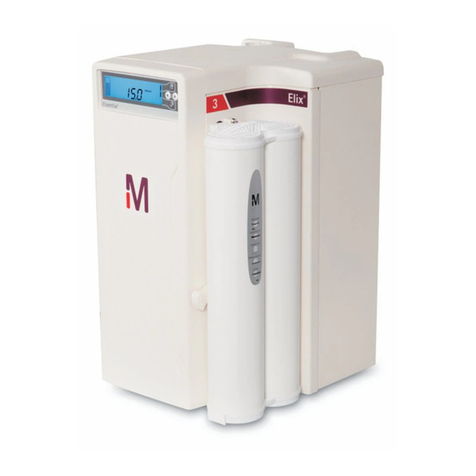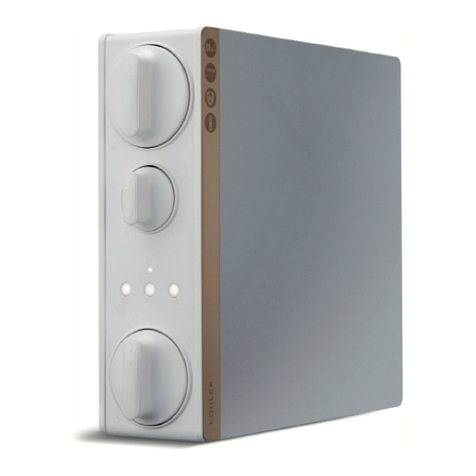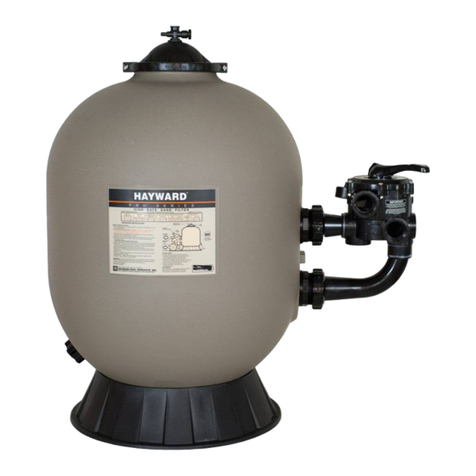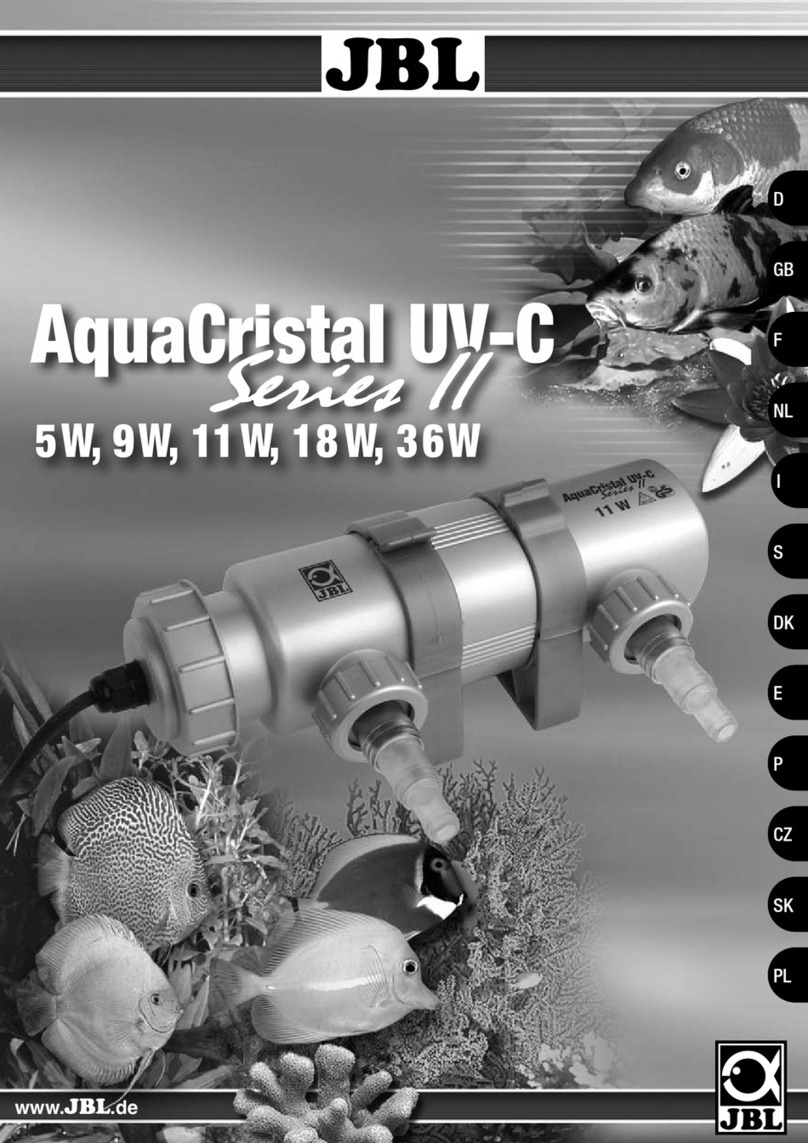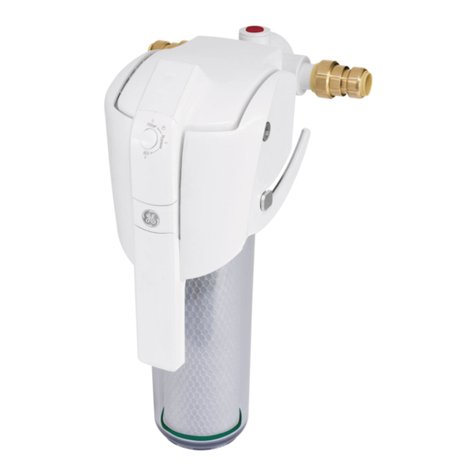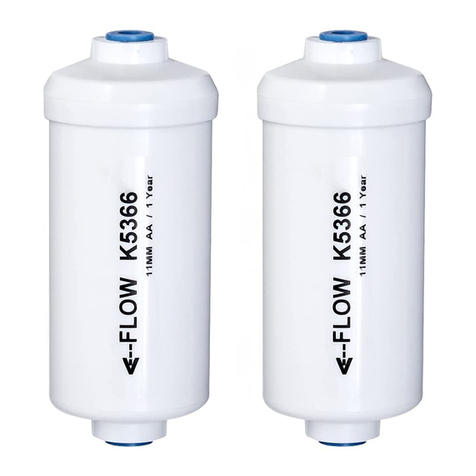Crystal Quest Whole House Operating instructions

Crystal Quest® Point of Entry (POE) Whole House Water Filter System
INSTALLATION AND OPERATION GUIDE
OPERATING SPECIFICATIONS
Pressure Range: 30-60 psi (2.1-4.1 bar)
Temperature Range: 40-100ºF (4.4-37.7ºC)
Optimum Service Flow: 8-13 gpm (30.28-49.21 lpm)*
*Depending on the size of the system Read all instructions, specifications, cautions, and warnings
before installing and using your water filter system.
All drawings, pictures, colors and sizes are approximate for illustrative purposes only and may not exactly resemble the end product.
Components

REMEMBER, YOUR PURCHASE IS AN INVESTMENT AND NEEDS TO BE MAINTAINED PROPERLY.
• Do not run ½” I.D. semi-rigid drain tube more than 20 running feet. If over 20 ft., increase
drain line tubing size to ¾” I.D. for the entire length of tube.
• Have control valve set correctly for your specific water needs.
• If more than one unit is being installed, the regeneration/backwash times should be
staggered.
• A pressure regulator, such as a slow-flow regulator, must be installed in front of the unit’s
water inlet if the water pressure (including any possible pressure spikes) could exceed 60 psi.
The most common operating water pressure range is 35-65 psi. Failure to comply will void the
warranty. Crystal Quest® assumes no liability for damage caused by excessive water pressure.
• Check all the connections (i.e., water hose/tubing, connectors/fittings) to ensure proper
connection and to avoid leaks.
• The filter cartridges used with this system have a limited service life. Changes in taste, odor,
color, and/or flow of the water indicate that the cartridge should be replaced. Change
cartridges routinely.
• After prolonged periods of non-use (such as during a vacation), it is recommended that the
system be flushed thoroughly. Let water run for 10-20 minutes before using.
• Check plumbing inlet and outlet to ensure the proper flow of water through the system.
• Plug system into a 110-volt outlet which contains a fuse or circuit breaker of 20 amps.
• Locate the system near a cold water supply line. Do not set the system farther than 15 ft. from
the cold water line.
• Do not use the system on cold water supply line with less than 20 psi.
• Do not use the system where water is microbiologically unsafe or with water of unknown
quality.
• All water treatment installations must conform to local plumbing, electrical and sanitation
codes. These codes are established for your protection. Check with your local public works
department for current plumbing codes.
• Installation errors can cause property damage. Crystal Quest® assumes no liability
whatsoever for systems improperly installed or those installed by someone other than a
licensed plumber or qualified contractor. A leak detector valve is recommended to avoid
accidental property damage. See page 13.
• The contaminants or other substances removed or reduced by the selected cartridge(s) are
not necessarily in your water. Ask your local water municipality for a copy of their water
analysis, or have your water tested by a reputable water lab.
IMPORTANT INFORMATION
Installation must be made within an area protected from the elements and freezing.
The unit must be protected from rain, dust, flooding, snow, freezing, and direct sunlight
(the system’s exposure to direct sunlight may cause algae growth). Failure to comply
will void the warranty.
SAFETY PRECAUTION
Read all instructions, specifications, cautions, and warnings before
installing and using your water filter system. Learn the specific
details regarding installation and use. Failure to follow them could
cause serious property damage.
Installation errors can cause property damage. All equipment
needs to be plumbed into the water system by a licensed plumber.
These guidelines must be followed during system installation:
• Use the system on a potable, safe-to-drink, COLD water supply
only.
• The system is for indoor use only.
• Turn the cold water line off while installing the system.
• When installation is completed, re-check the system to ensure
there are no leaks or drips.
• The outlet must be within reach of the power cord. Do not use an
extension cord. Extension cords that are too long or too light do not
deliver sufficient voltage to the unit and could present a safety
hazard.
• The rubber O-ring provides a watertight seal between the cap and
the bottom of the housing. Make sure the O-ring is properly seated
in the groove below the threads of the housing or a water leak could
occur.
• Do not cross-thread fittings or housings. If cross-threaded, place
the unit out of service.
Water testing by an independent third-party lab will attest to
contamination removal and validity of toxicology testing. California
residents are advised to have their water tested to ensure the water
filter system is in compliance with Proposition 65.
2

TABLE OF CONTENTS
Important Information and Safety Precautions................................................................................................................ 2
Arrival, Unpacking, and Inspection...................................................................................................................................4
System Location................................................................................................................................................................4
Installation Diagrams........................................................................................................................................................5
Installing Optional UV Lamps...........................................................................................................................................6
Assemble Water Filter System with Control Valve and Brine Tank (Mechanical and Automatic)......................................7
Programming Automatic Control Valve............................................................................................................................8
Connecting Water Filter System to Water Supply............................................................................................................9
Connecting Pre- and Post-Filters to Water Supply.........................................................................................................10
Connecting Tubing to Control Valve..............................................................................................................................11
Connecting Tubing to Brine Tank...................................................................................................................................12
How to Avoid Accidental Property Damage..................................................................................................................13
Installing the Leak Detector Valve..................................................................................................................................13
Guide for Replacing Media.............................................................................................................................................14
Replacing Filter Cartridges and Maintenance.................................................................................................................15
Maintenance for Water Softeners....................................................................................................................................15
Troubleshooting..............................................................................................................................................................16
Frequently Asked Questions...........................................................................................................................................17
One Year Limited Warranty..............................................................................................................................................18
Ordering Replacement Cartridges .................................................................................................................................18
ALL POINT OF ENTRY SYSTEMS MUST BE INSTALLED BY A LICENSED PLUMBER TO AVOID PROPERTY DAMAGE.
*Specifications are subject to change
without notice.
INFORMATION & ASSISTANCE
WWW.CRYSTALQUEST.COM
CUSTOMER SERVICE
1-800-934-0051
Hours of Operation:
Monday to Friday
9 AM to 5 PM EST
SUPPORT@CRYSTALQUEST.COM
Contact us for questions about your order,
technical support and product information,
or general comments or questions.
The system needs to be installed by a licensed plumber in any state or country. Specifically, the
following states require a licensed plumber OR allow a state-registered installer or contractor to
install your water filter system: AR, CA, GA, KS, MA, MI, MN, OK, RI, SC, SD, TX, VT, and WI.
3

ARRIVAL, UNPACKING, AND INSPECTION
• Inspect the carton and water filter for evidence of rough handling and concealed damages.
If contents appear damaged, ask driver or contact the carrier for a damage claim form to fill
out. Notify shipper immediately.
• Remove components from the shipping carton. Check that all installation parts are present,
which includes the unit and installation hardware.
• Make a complete inspection of the system to ensure that:
a) there are no physical damages to the system,
b) all accessories are present,
c) and the system is clean and dust free.
• Pipe, shut-off valves, and fittings are not provided by Crystal Quest®.
CHECK LIST WATER FILTER SYSTEM
• Unpack the water filter from the shipping box.
• Unpack the control valve from the shipping box.
• Unpack the water softener, tannin, or nitrate
water filter system from the shipping box.
• Check the entire water filter system for any loss
of parts.
• Parts needed to install the water filter (control
valve and softener) are packaged in a plastic bag.
To avoid loss of the small parts, keep them
packaged until you are ready to use them. Be sure
not to discard components hidden in packaging.
All Point of Entry Whole House models with
backwashing and regeneration/backwash
programming
All Point of Entry Whole House models with
regeneration/backwash programming
All Point of Entry Whole House models with
regeneration/backwash programming
ALL MODELS SUBJECT TO CHANGE WITHOUT NOTICE.
Read all instructions carefully to learn the details for installing and using your
P.O.E. water filter system. Failure to follow the Installation and Operation Guide
could cause injury and/or property damage.
SYSTEM LOCATION
Select the location of your water filter system with care.
For correct installation, refer to the appropriate diagram.
Various conditions which contribute to proper location
are as follows:
• Do not locate the system where the environment
would offer any risk of water contamination.
• Do not put any liquid other than water into the
system.
• Position the water filter near main water supply line,
drain and electrical outlet. Position so that main water
supply shut-off valve is between water filter and main
water source.
• Turn off the water flow to the house while installing
system.
• Select location where floor is level. If floor is rough
and/or uneven, you can level by placing tanks on 3/4”
plywood, and shim to level as needed.
• Install the water filter by positioning it BEFORE the
water heater
• Water temperatures above 100°F (38°C) will damage
the water filter. Use on cold water line only.
• Allow sufficient space around the installation area for
easy servicing.
• Provide a non-switched 110/120V, 60Hz power source
for the control valve (automatic/softener system).
4

The system needs to be installed by a licensed plumber in any state or country. Specifically, the following states require a licensed plumber OR
allow a state-registered installer or contractor to install your water filter system: AR, CA, GA, KS, MA, MI, MN, OK, RI, SC, SD, TX, VT, and WI.
TYPICAL INSTALLATIONS AND SYSTEM LOCATIONS
COMBO SYSTEMS CAN BE CUSTOMIZED BASED ON WATER CONDITIONS/LAB REPORTS.
*ORIENTATION OF TANKS ARE BASED ON WATER REPORTS/CONDITIONS *IN SOME CASES, DIRECTION OF WATER FLOW IS FROM LEFT TO RIGHT.
Mechanical System/Polyglass Water Filter System Automatic System/Polyglass Water Filter System Softener, Tannin or Nitrate System/
Stainless Steel Water Filter System
BYPASS
COLD WATER
WATER
HEATER
SHUT OFF
VALVE
SHUT OFF
VALVE
SHUT OFF
VALVE
FLOOR DRAIN
WATER METER
WATER SUPPLY
HOT WATER
OUTSIDE TAP
WATER
COLD WATER
HOT WATER
SHUT OFF
VALVE
SHUT OFF
VALVE
SHUT OFF
VALVE
FLOOR DRAIN
WATER METER
WATER SUPPLY
OUTSIDE TAP
WATER
WATER
HEATER
WATER
HEATER
COLD WATER
HOT WATER
SHUT OFF
VALVE
SHUT OFF
VALVE
SHUT OFF
VALVE
FLOOR DRAIN
WATER METER
WATER SUPPLY
OUTSIDE TAP
WATER
Automatic System/Polyglass Water Filter System
BYPASS
SHUT OFF
VALVE
SHUT OFF
VALVE
COLD WATER
HOT WATER
FLOOR DRAIN
WATER METER
WATER SUPPLY
OUTSIDE TAP
WATER
Softener, Tannin or Nitrate System/
Triple Stainless Steel Water Filter System
Softener, Tannin or Nitrate System/
Quad Stainless Steel Water Filter System
BYPASS
SHUT OFF
VALVE
COLD WATER
HOT WATER
FLOOR DRAIN
WATER METER
WATER SUPPLY
OUTSIDE TAP
WATER
BYPASS
SHUT OFF
VALVE
COLD WATER
HOT WATER
FLOOR DRAIN
WATER METER
WATER SUPPLY
OUTSIDE TAP
WATER
(WITH BACKWASH OR REGENERATION FEATURES)
5
WATER
HEATER
WATER
HEATER
WATER
HEATER
SHUT OFF
VALVE
SHUT OFF
VALVE
SHUT OFF
VALVE SHUT OFF
VALVE
SHUT OFF
VALVE

DOWNFLOW WITH NO BACKWASH WATER FILTER SYSTEMS
This system is ideal for acidic water conditions or as a post-filter for a
reverse osmosis system to remineralize and enhance pH. This design will
allow quick and easy media refill.
CONNECTING TO GALVANIZED PIPE
CONTROL VALVE
GALVANIZED PIPE
OR NIPPLE
CONNECTING TO PLASTIC PIPE
CONTROL VALVE
PLASTIC PIPE
SOLVENT BOND
FITTING
• Electronic ballast must be connected to a grounded
outlet, and the lamp connector ground wire must be
connected to the stainless steel reactor chamber.
• This disinfection system is designed to be mounted
horizontally or vertically at the point of use or point of
entry, depending on the specific flow rate of the unit.
• The UV disinfection system is intended for indoor use
only.
• Do not install disinfection system where it may be
exposed to the weather or temperatures above 100ºF.
UV INSTALL
HINTS
Refer to section
"CONNECTING
WATER FILTER
SYSTEM TO WATER
SUPPLY" for detailed
instructions.
ULTRAVIOLET WATER STERILIZER SYSTEM
This system is great for well water and as an add-on to any
whole house water filter. For detailed installation instructions,
refer to the UV Installation and Operations Guide.
6
CONNECTING UV TO GALVANIZED PIPE* CONNECTING UV TO PLASTIC PIPE
INLET
OUTLET
ULTRAVIOLET
INLET
OUTLET
ULTRAVIOLET
GALVANIZED PIPE
OR NIPPLE PLASTIC PIPE
OR NIPPLE
SOLVENT
BOND
FITTINGS
(UV PLACEMENT IS OPTIONAL BASED ON WATER FEED SOURCE.)
BYPASS
SHUT OFF
VALVE SHUT OFF
VALVE
COLD WATER
HOT WATER
FLOOR DRAIN
WATER METER
WATER SUPPLY
OUTSIDE TAP
WATER
OPTIONAL
SHUT OFF
VALVE
SHUT OFF
VALVE SHUT OFF
VALVE
ULTRAVIOLET
BULB
OPTIONAL
SHUT OFF
VALVE
PRE-FILTER
POST-FILTER
ULTRAVIOLET
BULB
WATER HEATER TANNIN SOFTENER
BRINE TANK
To change the UV
bulb, follow
instructions provided
in the UV Installation
and Operation Guide.
Pipe and shut-off
valves are not
provided by
Crystal Quest®

ASSEMBLE WATER FILTER SYSTEM WITH CONTROL VALVE AND BRINE TANK
CAUTION - DO NOT OVERTIGHTEN COMPRESSION NUT! HAND TIGHTEN AND ADD A HALF TURN WRENCH.
Unpack the control valve from the shipping box. It is recommended that you keep the original boxes
and packing materials.
1 2 34
5 6 7
Unscrew and remove the top
cap from unit.
Unplug slip cap from the
distributor/riser tube (also referred
to as a PVC tube).
To prevent leaks, lubricate the
inner and outer O-rings on the
bottom of control valve with food
grade silicone lubricant.
Twist and lock top distributor to the
bottom of control valve. Ensure it is
fully locked in place.
Attach control valve to the tank by sliding distributor tube into top
distributor. Turn control valve clockwise to tighten. Distributor tube
needs to be equal to the top of the resin tank (not more than 1/4"
above). Lubricate the inner O-ring prior to attaching the control
valve to the tank.
Attach bypass valve to the back
ports of the control valve by
sliding the bypass over the
O-rings and tighten (it is held in
place by two metal clips and
two screws).
Attach drain line hose barb and
compression nut of the brine tank
by turning clockwise to tighten
until snug. To prevent leaks, wrap
threads of hose barb and
compression nut with Teflon® tape
clockwise, approximately 3 times
around.
TOP
DISTRIBUTOR
CONTROL
VALVE
CONTROL
VALVE
TOP
DISTRIBUTOR
DISTRIBUTOR
TUBE
O-RING
TANK
DRAIN LINE
HOSE BARB
COMPRESSION NUT
OF BRINE TANK
CONTROL VALVE
(BACK VIEW)
CONTROL VALVE
(FRONT VIEW)
DRAIN CONNECTOR
CLAMP
TANK
TOP DISTRIBUTOR
DRAIN
BOTTOM
DISTRIBUTOR
DOWN-FLOW SYSTEM
DISTRIBUTOR/
RISER TUBE
7
SLIP CAP
DISTRIBUTOR/
RISER TUBE

PROGRAMMING AUTOMATIC CONTROL VALVE
1) Use the up or down arrows to set the time to 12:01
PM. Once the time is changed to 12:01 PM, push the
Recycle button (refer to Figure A1) to lock it in.
2) Push and hold both arrow buttons until screen
changes to read “GAL”.
3) Push Recycle button. Screen will read “DF 1b”. This
is set at factory and will not need to be changed.
4) Push Recycle button. Screen should read “tc”. If not,
use up/down arrow buttons to set to “tc”.
5) Push Recycle button. Screen will read “NT ---1”. This
is the number of tanks the timer is controlling (one
tank). Do not change this.
6) Push Recycle button. Screen should read “DO 7”. If
not, use up/down arrow buttons to set number to 7.
7) Push Recycle button. Screen should read “RT 2:00”.
* If not, use up/down arrow buttons to set to 2:00.
8) Push Recycle button. Screen should read “BW 10”. If
not, use up/down arrow buttons to set to 10.
9) Push Recycle button. Next screen will be “BD 60”.
Use up/down arrow buttons to change screen to read
“OFF”.
10) Push Recycle button. Screen will change to time
display and programming is locked in.
*If more than one tank is being used, regeneration
time (RT 2:00) should be staggered for each tank.
Programming to backwash non-regeneration
systems once every 7 days:
1) Use the up or down arrows to set the time to 12:01
PM. Once the time is changed to 12:01 PM, push the
Recycle button (refer to Figure A1) to lock it in.
2) Push and hold both arrow buttons until screen
changes to read “GAL”.
3) Push Recycle button. Screen will read “DF 1b”. This
is set at factory and will not need to be changed.
4) Push Recycle button. Screen should read “tc”. If
not, use up/down arrow buttons to set to “tc”.
5) Push Recycle button. Screen will read “NT ---1”.
This is the number of tanks the timer is controlling (one
tank). Do not change this.
6) Push Recycle button. Screen should read “DO 7”. If
not, use up/down arrow buttons to set number to 7.
7) Push Recycle button. Screen should read “RT 2:00”.
* If not, use up/down arrow buttons to set to 2:00.
8) Push Recycle button. Screen should read “BW 10”.
If not, use up/down arrow buttons to set to 10.
9) Push Recycle button. Screen should read “BD 60”.
If not, use up/down arrow buttons to set to 60.
10) Push Recycle button. Screen should read “RR 10”.
If not, use up/down arrow buttons to set to 10.
11) Push Recycle button. Screen should read “BF 12”.
If not, use up/down arrow buttons to set to 12.
12) Push Recycle button. Screen will change to time
display and programming is locked in.
*If more than one tank is being used, regeneration
time (RT 2:00) should be staggered for each tank.
Programming to backwash Softener, Nitrate, or
Tannin systems to regenerate once every 7 days:
Programming to Backwash and Regenerate
using an Automatic Valve
Programming to Backwash
using the Mechanical Control Valve
• When programming the mechanical valve to backwash, firmly grip
the handle, turning it counterclockwise from the service FILTER (M1)
position.
• Lock the handle to the BACKWASH (M2) position.
• Allow the water to run through the unit for five minutes or until the
water becomes clear and free of dust or media fines.
• Manually turn the control knob clockwise to the service FILTER (M3)
position. Your unit is back in service and ready to operate.
CAUTION - FAILURE TO FULLY LOCK DISTRIBUTOR WILL CAUSE IMPROPER OPERATION.
A1 A2
M1 M2
M3
BACKWASH
FILTER
8
(Refer to instructions for programming Automatic Control Valve)
(See Instructions Below)
*For more about automatic valve settings please refer
to our "Frequently Asked Questions" on Page 17.

CAUTION - IF COPPER PIPING WITH SWEAT FITTINGS IS USED, DO NOT SWEAT DIRECTLY INTO THE IN/OUT MANIFOLD
OF SOFTENER VALVE OR BYPASS VALVE. HEAT WILL DAMAGE PLASTIC PARTS.
CONNECTING WATER FILTER SYSTEM TO WATER SUPPLY
• Turn off the main water shutoff valve.
•Open all plumbing fixtures in the house
including all outside faucets in order to drain the
lines of all water.
• Cut and remove a section of the main incoming
water line near where the system is to be
installed. Allow this line to drain thoroughly (Fig
8).
• If copper piping is used and soldered, remove
the bypass from the valve assembly and attach
your plumbing adapters to the bypass away from
the valve. This simple step will ensure that you
are not applying heat as you solder, or pressure
as you tighten the adapters onto the bypass
while they are mounted on the valve body itself.
•Solder a 3" to 5" piece of copper pipe into
each of the two pipe adapters away from the
valve, then let them cool before threading each
one onto the yoke or bypass valve (Fig 9).
• Apply Teflon® tape onto the male adapters for
the brass bypass valve when cool, and securely
tighten them to the bypass valve. This is done
before reattaching them onto the rear of the
valve/meter body assembly.
• Close main water supply shutoff valve.
•Open nearest faucet to relieve pressure and
drain plumbing lines.
• ¾" or 1" male thread adapters to plumb the
system
• Wrenches, either open end or adjustable jaw, sized
to fit compression adapters
• Pipe cutter
• Teflon® tape
• Sandpaper or emery cloth
• Before installing ¾" or 1" fittings to the inlet and
outlet of the bypass valve or manifold, wrap the
threads 3 times around with Teflon® tape. Install ¾"
or 1" fittings.
• Soldering is no longer required to plumb with
copper pipe. Instead, use ¾" or 1" compression
fittings. Connect plumbing as shown below (Fig 10),
choosing appropriate connection for
mechanical/automatic control valve.
CAUTION: Do not overtighten or cross-thread.
CAUTION: Install water filter in direction of arrows.
MINIMUM MATERIALS NEEDED
89
Cut out section of main water
supply line downstream from
the supply shut off at position
water filter is to be installed.
Using a pipe cutter, sand (file)
cut ends of pipe to ensure that
they are square and smooth.
Check plumbing inlet and outlet
to ensure the proper flow of
water through the unit. Match
plumbing inlet and outlet with
arrows located on the sides of
the valve head and on the
bypass valve.
10 Connecting to galvanized pipe Connecting to plastic pipe Connecting to copper pipe
X
OUTLET
INLET
AUTOMATIC
CONTROL
VALVE
INLET
OUTLET
GALVANIZED PIPE OR NIPPLE
INLET
OUTLET
AUTOMATIC
CONTROL
VALVE
SOLVENT
BOND
FITTING
PLASTIC PIPE
AUTOMATIC
CONTROL
VALVE
INLET
OUTLET
SOLVENT
BOND
FITTING
COPPER PIPE
GALVANIZED PIPE OR NIPPLE
MECHANICAL
CONTROL VALVE
PLASTIC PIPE
MECHANICAL
CONTROL VALVE SOLVENT BOND
FITTING
9
(Choose appropriate connection below)
MECHANICAL/AUTOMATIC

13 POLYPROPYLENE FILTER - Choose appropriate connection below
Connecting to plastic pipe Connecting to copper pipe Connecting to galvanized pipe
MINIMUM MATERIALS NEEDED
• Tape measure or ruler
• 4 hex washer-head screws
• Anchors
• Pipe cutter
• Teflon® tape
• Sandpaper or emery cloth
• Before installing ¾" or 1" fittings to the inlet and outlet
of the bypass valve or manifold, wrap the threads 3 times
around with Teflon® tape. Install ¾" or 1" fittings.
• Soldering is no longer required to plumb with copper
pipe. Instead, use ¾" or 1" compression fittings. Connect
fitting as shown below (Fig 13).
• Select a secure location surface to install filter and mounting bracket. The location
should align the filter system with inlet and outlet pipe and should not cause the
pipes to bend or get damaged. Mark the distance "X" on the pipe.
• The bracket can be used as a template for marking the location of the mounting
screws (Figures 11 & 12).
• Use four hex washer-head screws to mount bracket firmly to wall. Use proper
anchors on wall. Anchors and screws are NOT included.
• Apply 4 or 5 wraps of Teflon® tape, in a clockwise direction, to the pipe threads
of each fitting. DO NOT use joint compound on any parts connecting to filter
housing.
• Turn fittings clockwise to tighten. Do not overtighten.
Connecting to copper pipe Connecting to galvanized pipe
TURN FITTING CLOCKWISE TO TIGHTEN. DO NOT OVERTIGHTEN. DO NOT CROSS-THREAD.
IMPORTANT: A copper or galvanized cold water pipe is often used to ground electrical outlets
in the home. Grounding protects you from electrical shock. The water filter housing may have
broken this ground path. To restore connection, install an 18” long, 6-gauge copper wire across
the filter, tightly clamped using UL ap-proved 1/2”-1” bronze grounding clamps at both ends as
shown. Zinc clamps should not be used on copper plumbing. Wire and clamps may be
purchased separately from your local hardware store. With emery cloth, clean copper pipe and
ends of wire. Bare wire is recommended. If insulated wire is used, it should be stripped 3/4” at
each end before cleaning with emery cloth.
• Attach bronze clamps to pipe. Tighten screws.
• Attach wire to clamps as shown. Tighten screws.
11 12
13 STAINLESS STEEL FILTER - Choose appropriate connection below INSTALLING GROUND WIRE
Turn off the water supply and open a
nearby faucet to drain the water out of
pipes. Using a tape measure or ruler,
measure the distance "X" as shown.
Using a pipe cutter, cut pipe. Sand (file)
cut ends of pipe to assure that they are
square and smooth.
X
X
INLET
OUTLET
PLASTIC PIPE
SOLVENT
BOND
FITTINGS
INLET
OUTLET
COPPER PIPE
SOLVENT
BOND
FITTINGS
INLET
OUTLET
GALVANIZED PIPE
INLET
OUTLET
COPPER PIPE
SOLVENT
BOND
FITTINGS
INLET
OUTLET
GALVANIZED PIPE
CLAMP CLAMP
GROUND WIRE
10
CONNECTING PRE- AND POST-FILTERS TO WATER SUPPLY
Pre-filter: Sediment Cartridge
Post-filter: Carbon Block (for EAGLE systems, the UltraFiltration Cartridge is Post-filter 2)

CONNECTING TUBING TO CONTROL VALVE - MECHANICAL AND AUTOMATIC
Press 1/2" I.D. semi-rigid or non-collapsible plastic tubing onto drain line hose barb until
snug and secure with a hose clamp (Figs 14 and 15).
• Plug cord from control valve into
110V electrical outlet. Make certain
that outlet is supplied with power at all
times. Make sure area is dry before
plugging the unit in (Fig 16). Open
main water supply shutoff valve.
• CHECK FOR LEAKS! Close previously
opened faucet.
NOTE: Do not run 1/2" drain line over
20'. If over 20', increase tube size to
3/4".
CONNECTING TUBING TO BRINE TANK
• Connect tubing to control valve as shown in Figures
14 and 15 for the mechanical and automatic water
filter systems.
• For connecting tube to brine tank (softener, nitrate
and tannin systems), see Fig 17 below:
(1) Slide the brass insert into brine tube and slide
compression nut onto brine tube.
(2) Turn compression nut clockwise with wrench to
tighten. DO NOT OVERTIGHTEN.
14 15
16 17
TRANSFORMER OUTLET
BRASS INSERT
11
PLASTIC TUBING
PLASTIC TUBING

CONNECTING TUBING TO BRINE TANK
CAUTION - DO NOT OVERTIGHTEN COMPRESSION NUT! HAND TIGHTEN AND ADD A HALF TURN WITH A WRENCH.
• Install 1/2" I.D. semi-rigid or non-collapsible tubing (not included) to the overflow
hose barb located on the side of the softener brine tank and run to a suitable drain.
Do not connect to drain line off of softener (Figs 22 & 23).
• Plug cord from control valve into 110V grounded electrical outlet. Make certain
that outlet is supplied with power at all times. Make sure area is dry before plugging
the unit in (Fig 25).
• Open main water supply shutoff valve. CHECK FOR LEAKS! Close previously
opened faucet.
• Pour the 5-gallon bucket of water into the brine tank.
• Pour 1-1/2 oz. of chlorine bleach solution directly into the brine tank or
salt/potassium permanganate compartment.
• Pour salt or potassium permanganate into brine tank component (not included).
Fill tank 1/2 - 3/4 full (do not pack full) and add water until it is just above the salt
level. To read more about brine tanks and where to buy salt, refer to our
"Frequently Asked Questions" on page 17. If any red rust stains are apparent, mix
iron control agents (Super Iron Out®) with the salt or potassium permanganate.
18 19 and 20 21 22 & 23
Remove the black brine tank lid. Remove the small white lid from the inside of the brine tank.
Lift out parts inside and unscrew bolt. Thread the screw through the pre-made hole,
and use the bolt to secure in place.
Remove the black plastic screw on opposite side and
thread the hose through the tank.
Place the black screw and additional parts around the hose
and then screw securely into place.
24
TRANSFORMER
25
OUTLET
12

INSTALLING A LEAK DETECTOR VALVE
Crystal Quest Point-of-Entry Water Filters use the latest
technologies available to ensure and prevent water rupture.
However, if manufacturing guidelines are not followed, water
damage can occur. Causes of flooding include excessive water
pressure, spikes in water pressure, human tampering, and
negligent installation.
To eliminate possible water and property damage, use the
following preventative steps and devices:
1. A licensed plumber should install this unit, reading and
following the Installation and Operation Guide as well as all
notices.
2. Install a water pressure regulator/control valve inline to keep
the water inflow pressure at 60 psi or less.
3. Keep the water supple line from the extreme heat or
freezing. Temperature at unit location should be maintained
between 35F and 120F.
4. Install an inline flood prevention valve/leak control (available
at CrystalQuest.com) – instructions at right.
5. In addition to having all other safety devices, use a ball valve
to bypass the inflow of water to the system during vacation.
13
Leak Controllers are specialized water alarm and shut-off systems that use sensors
to detect a water leak. The sensor sounds an alarm and then shuts off your water. The
alarm continues to sound until the valve is manually reset. By preventing continuous
water flow, mold and property damage are restricted.
FEATURES
- 1” full port ball valve with auto shut-off
- Programmable service reminder indicator
- Water detection sensitivity down to 2ppm TDS (total dissolved solids)
- 4 AA alkaline batteries
- Automatic daily valve management
- Available port sizes (inlet/outlet) 3/4 “, 1”, 1-¼” and 1-½”
BYPASS
SHUT OFF
VALVE
SHUT OFF
VALVE
COLD WATER
HOT WATER
FLOOR DRAIN
WATER METER
WATER SUPPLY
OUTSIDE TAP
WATER
WATER
HEATER
SHUT OFF
VALVE
SENSOR*
CONTROLLER
MODULE
FULL
PORT
VALVE
1) INSTALL LEAK DETECTOR VALVE INTO INLET WATER LINE
2) MOVE SENSOR AS CLOSE TO FILTER AS POSSIBLE.
UPON SENSING MOISTURE, CONTROLLER WILL ENGAGE THE
SHUT-OFF VALVE AND SOUND AN ALARM.
3) SECURE CONTROLLER MODULE TO WALL
HOW TO AVOID ACCIDENTAL PROPERTY DAMAGE

GUIDE FOR REPLACING MEDIA
1. Turn off the water to the unit and unplug from the power source.
2. Disconnect the unit from your plumbing.
3. Carefully unscrew the control valve off the top of the tank.
4. Remove the riser tube from inside the mineral tank.
5. Lay the tank on its side or lay over a trash can to remove media.
6. Rinse the inside of the tank clean with a garden hose, discard old resin, and save the old gravel.
7. Stand media tank upright. Plug a slip cap or put a piece of tape over the top of the distributor/riser tube to prevent media from
entering the tube while loading the media.
8. Place the media funnel in the top of the media tank with the riser tube still inside and centered.
9. Begin replacing media by putting gravel into the tank first. Make sure the riser tube is firmly on the bottom of the tank. If the riser
tube is pulled out of the gravel once the media is added, it is impossible to put it back in without removing the other media from the
tank.
10. Pour resin/media into the funnel, slowly letting it fall down inside the media tank around the riser tube. If you have a twin
alternating system, divide the resin/media equally between the two tanks. The media tank should be approximately 3/4 full. The
media tank should be approximately ¾ full but this can vary based on the media for your specific system.
11. Remove the funnel and the slip plug or tape from the top of the riser tube.
12. Brush any loose resin/media off the top opening of the tank. Clean the top edge with a cloth so the O-ring can seal securely to
the valve base. Lubricate o-ring with clean food grade silicon grease.
13. Look at the bottom of your control valve and locate the upper basket. Inside the basket, the control valve has O-rings that will seal
on the riser tube. Install the valve on top of the media tank, making sure the top of the riser tube inserts inside the opening of the
upper basket. Guide the riser into the O-ring seal and tighten gently. Be careful not to over-torque the valve as the threads are plastic.
14. Screw the control valve back onto the top of the tank. Be sure to hold the control valve where there will be no damage to the valve
from the pressure you exert from tightening the valve back onto the tank.
15. Reconnect your plumbing to your unit and plug the control valve back in, making sure to set the correct time of day. Turn on the
water to the unit and check for leaks.
16. Leave all faucets turned off inside the house, and open a single faucet (such as an outside faucet), letting the water run for 3-5
minutes. This rinses the new resin/media inside the tank, and any particles or color will rinse out through the one open faucet, and not
throughout your home plumbing system.
17. Manually turn your regeneration/backwash control knob slowly through a complete cycle, allowing the water to run through the
unit for a minute or so in each position.
18. Once the regeneration/backwash knob is back in the service position, your unit is in service and ready to operate!
For details on replacement media or to order replacement media, visit http://www.crystalquest.com/whole-house-water-filters.htm
FUNNEL
DISTRIBUTOR/
RISER TUBE
SLIP CAP
14

REPLACING FILTER CARTRIDGE AND MAINTENANCE
• You should change your filter cartridge when the water flow is
noticeably reduced and/or between 12-18 months.
• Turn off water to filter. Water must be shut off from an upstream
valve or bypass.
• Unscrew the filter sump and discard used cartridge.
• Wash the filter sump with mild soap and water. Do not use harsh
cleaners or hot water.
• Inspect the filter sump O-ring. Make sure it is lightly lubricated
with clean food grade silicone grease. Be sure the O-ring is seated
in the groove.
• It is recommended that you replace the O-ring as needed or if it
becomes damaged.
• Place a new filter cartridge into the sump, making sure it is
centered and completely seated on the bottom seal.
• Reinstall the filter sump to the unit. Use the sump wrench to
tighten the sump. DO NOT OVERTIGHTEN.
• Slowly turn on water to the filter by using the upstream shut-off
valve or bypass.
• After installation, flush the cartridge for 10 minutes, wait one
hour, and then flush again for 10 minutes before using the water.
Water softeners work using a process called ion exchange.
Your water softener replaces harmful calcium and
magnesium ions with neutral sodium chloride / potassium
chloride ions. The mineral exchange takes place in one tank
as water passes over plastic beads coated with sodium
chloride / potassium chloride ions. A second tank (called a
brine tank) replenishes the sodium chloride / potassium
chloride as it is used up during the mineral exchange
process. Here's how to keep your water softener in top
shape:
• Inspect the sodium chloride / potassium chloride level in
the brine tank at least once a month. If your water softener
has recently been installed, check more frequently until you
can gauge how much sodium chloride / potassium chloride
your unit will require. Fill tank about ¾ full. Do not pack full.
Do not use block salt or block potassium chloride.
•Sodium chloride / potassium chloride in your water
softener's brine tank can form solid cakes that inhibit the
proper operation of the unit. As you inspect your brine tank,
look for large clumps of solidified sodium chloride /
potassium chloride. As a temporary measure, caked salt can
be broken up with a broom handle or other long, solid
object. Bridged salt will bridge again at a much faster rate
and should be removed as soon as possible.
• If iron is present in the water supply, the softener will
eventually become iron fouled, resulting in reduced
softening capacity and rust stained fixtures. Mixing one or
two ounces of Super Iron Out® or similar resin bed cleaner
with every 80 Ibs. of sodium chloride / potassium chloride
added to the brine compartment will minimize these
problems.
• Periodically check time setting. Power outages will cause
timer/meter setting to become incorrect. To reset, refer to
"Setting the Control Valve".
• Once a year, your brine tank should be drained, emptied
and cleaned with soap and water. The tank should be rinsed
well and refilled.
• Should your family size, your water usage habits or your
water quality change, the regeneration program setting may
have to be adjusted. Do not lower salt setting.
MAINTENANCE FOR WATER SOFTENERS
For assistance with installation and maintenance, contact Service/Technical Support at service@crystalquest.com or toll-free 1-800-934-0051.
MAINTENANCE
• Periodically check time setting. Power outages will cause time of day setting to become
incorrect. To reset, refer to "Programming Automatic Control Valve."
• Should your family size, your water usage habits or your water quality change, the
regeneration/backwashing program setting may have to be adjusted. Do not lower salt setting.
FILTER
CARTRIDGE
HEAD
O-RING SEAL
SUMP
15

TROUBLESHOOTING
PROBLEM CORRECTION WATER FILTER SYSTEM
No water flow
Media discharging during
backwash/regeneration
Mechanical, Automatic, Water
Softener or Nitrate and Tannin
Filter Systems
Mechanical, Automatic, Water
Softener or Nitrate and Tannin
Filter Systems
Mechanical, Automatic, Water
Softener or Nitrate and Tannin
Filter Systems
Water Softener or Nitrate and
Tannin Filter Systems
Water Softener or Nitrate and
Tannin Filter Systems
Water Softener or Nitrate and
Tannin Filter Systems
Water Softener or Nitrate and
Tannin Filter Systems
Water Softener or Nitrate and
Tannin Filter Systems
Water Softener or Nitrate and
Tannin Filter Systems
System does not
backwash/regenerate
properly or regularly
• Re-read the instructions to install the system properly.
• Check the in and out arrows on the bypass valve to ensure the
system is not piped backwards.
• Make sure the bypass valve is in the "Service" position.
• Make sure top distributor has been installed properly.
• Control valve not programmed properly. Check
programming and re-program as needed.
• Check the well float in the brine tank. The well float
should be able to move up and down, and the hose should
be able to inject water into the tank and siphon it out again.
Poor performace
(filtration/softening ability)
• Check the resin media level in the tank. System should be 2/3
full.
• Check sodium chloride / potassium chloride level in brine
tank. This should be 3/4 full.
• Check the frequency and period of backwashing.
System uses too much
sodium chloride/potassium
chloride and excessive
water in brine tank
• Brine draw not functioning. Clean injectors. Check and
reset sodium chloride / potassium chloride settings.
Softener fails to regenerate • Electricity to system has been interrupted.
• Check the power source and programming of control valve.
Iron build up in water
conditioner and loss of
water pressure
• Clean control and add resin cleaner. Increase regeneration
frequently.
• Check the pre- and post-filters for timely replacement.
• Clean control and add resin cleaner. Increase regeneration
frequently.
Put the system in bypass position and depressurize* the unit by
putting into “Backwash" position. There are 2 screws on neck of
valve where the salt rinse line goes into softener. Remove the 2
screws and clean screen to remove any chunks of salt, etc.
Injector or injector screen
plugged
Leak in distributor tube
After prolonged periods of non-use
(such as during a vacation), it is
recommended that the system be
flushed thoroughly.
1. First put the system in bypass by
turning the bypass valve to the
"BYPASS" position.
2. Let water run for 10-20 minutes by
opening all faucets to flush the pre- and
post-filters and all water supply lines.
3. Turn handle on bypass valve to
"SERVICE" position to backwash* the
system.
*To backwash or depressurize the
system, refer to "Programming
Automatic Control Valve" in manual.
To review the latest edition of the
Installation and Operation Guide, visit
www.crystalquest.com.
!
16

17
FREQUENTLY ASKED QUESTIONS
What is shocking a well, is it necessary, and how do I do it?
• ‘Shocking a well’ refers to disinfection by means of chlorine to rid bacteria and other contaminants from
a well. It is definitely suggested if there is iron or sulfur in the well, if it a newly constructed well or an old
well that hasn’t been disinfected in a while. There are 3 techniques that can be used to shock a well
depending on your preference.
• Chlorination Techniques for Well Water:
1) Shocking a well with bleach: This is the cheapest and quickest way to shock a well. For shallow wells
(40 ft. or less) add a ½ gallon of bleach. For deep wells (40 ft. and over) add a gallon of bleach.
2) Using chlorination tablets: Similar to adding bleach, only specifically made to put into wells. Sold
through Crystal Quest®. Please call 1-800-934-0051.
3) Chlorine Injection Systems: A separate device to be tied straight into the line and set to automatically
pump a certain amount of chlorine into the water each day. Sold through Crystal Quest®. Please call
1-800-934-0051.
When is the ideal time to change the pre- and post- filters?
• Between 12-18 months. Please visit CrystalQuest.com for replacement cartridges.
What salt is used in the brine tank, where do I buy it, and how much of it will be used?
• Sodium chloride or potassium chloride, which can be bought at your local hardware store. Because of the
high costs associated with shipping these solutions, it is best to buy locally.
• The brine tank should be filled up about ½ to ¾ of the way with the salt and topped off with water (just
above the salt level). The user should attempt to maintain the level of solution around the halfway point in
the brine tank. It will slow decrease over time. When it reaches around 1/3 or ¼ of the original salt level,
add more to the halfway point.
Will my whole house system affect water pressure?
• As long as the appropriate sized system was installed for the house-size and water demand, there should
be very little change, or none at all. If you think you may have purchased the wrong sized system, please
contact us at 1-800-934-0051.
How do I reset an automatic head?
• Refer to page 8 in the manual and re-do steps under “Programming Automatic Control Valve”.
How often do you need to backwash a manual system?
• Generally, once a week for 10 minutes. In some conditions, it can be adjusted based on water conditions.
How can you do a manual backwash with an automatic head?
1) Press the Regeneration button and hold until it says ‘BW’
2) It will automatically begin a 10 minute backwash
Can I change my valve head?
• A new valve head can always be purchased if you find yourself wanting a different functioning head.
Please call us 1-800-934-0051.
I'm having issues with my media working properly, what should I do?
The answer most likely is too high of water pressure, resulting in ineffective media because there is not
enough contact time. The prime fix is to slow down incoming water by installing a pressure regulator which
allows the water more contact time with the media, thus allowing the media to do its job more effectively.
The same fix is for customers with very high native pressure that need to bring it down to a constant 50-60
psi(recommended) in order to use our systems. 1” & ¾” Pressure Regulators are available for purchase
through Crystal Quest®. Please call 1-800-934-0051 to order. If water pressure is not the issue and your
media is failing due to old age (older than 5-10 years depending on water conditions and consumption),
please visit CrystalQuest.com or call to buy new replacement media.
What do some of the pop-up acronyms mean on my automatic valve head?
•[Parameter Display - Data Display] Brief explanation of what the setting
controls and recommendations for correctly setting it.
•[Parameter Display - ****] A setting that should not be shown if setup correctly.
If you are seeing this setting check to ensure other settings are set correctly.
•[TD - 11:08] Time of Day, tells the system what the current time is. To change the
time, press and hold the up OR down arrow until the service icon is replaced with
the programming icon. Use the up and down arrows to set the time of day (PM is
indicated in the upper right corner of the screen). Once the time is set, press the
extra cycle button or don't press anything for 5-10 seconds to return to normal
operation.
•[DO - 7] Day Override, this setting will cause the system to backwash after the set
number of days. Typically set no higher than 3 to ensure the media gets lifted and
cleaned off.
•[RT - 2:00] Regen Time, this is the time of day the system will backwash. This
process typically takes 30 minutes - 2 hours depending on system size, so schedule
it when water will not be used. It is common to set to run when everyone is asleep,
and ensure it does not conflict with any other systems you may have.
•[DF - GAL] Display format, shown settings is gallons. Liters [Ltr] and Cubic Meters
[Cu] are alternative settings, however, all instructions are written on the basis of the
[Gal] display format.
•[VT - dF1b] Valve type, set to the downflow single backwash setting shown.
•[CT - tc] Control Type, sets the opereration of the controller. Backwashing systems
use the time clock [tc] setting where backwash is based on time (days) passed.
•[NT --- 1] Number of tanks holding media for treatment.
•[BW - 10] Backwash, the length of time used for the backwash part of the cycle,
actual setting varies depending on system size.
•[BD-60] Brine Draw for 60 minutes. This means that salt will be pulled from the
brine tank to the system to regenerate. Regenerating with brine draw backwashes
the media and puts water back into the brine tank.
If you still did not find your solution here, please contact our Service Department at
[email protected] or 1-800-934-0051.
*For any specific chemistry related questions about your water and/or the media
used, please call one of our water specialists at 1-800-934-0051.
?

ONE YEAR LIMITED WARRANTY
CRYSTAL QUEST® warrants your CRYSTAL QUEST® Point of Entry Whole House Water Filter System* for one year from
the date of purchase against all defects in materials and workmanship when used in compliance with the manual. This
warranty does not include replacement cartridges unless defective upon receipt. CRYSTAL QUEST® disclaims all implied
warranties including, without limitation, warranties of merchantability and fitness for a particular purpose. If for any reason
the product proves to be defective within one year from the date of purchase, please call for assistance. This warranty gives
you specific legal rights and you may have other legal rights which vary from state to state. CRYSTAL QUEST® assumes no
responsibility for incidental or consequential damages, for damages arising out of misuse of the product, or the use of any
unauthorized attachment. Some states do not allow the exclusion or limitation of implied warranties or incidental or
consequential damages; therefore, the above limitations or exclusions may not apply to you. Should service be required
during or after the warranty period or should you have any questions regarding how to use your CRYSTAL QUEST® Point
of Entry Whole House Water Filter System, please contact our Technical Support Department at [email protected],
Monday through Friday, 9 AM to 5 PM Eastern Time.
*Warranty varies on components of the whole house water filter system. Contact your Crystal Quest® Dealer or
Email [email protected] for more information.
Installation and Maintenance
Instructions
KEEP THIS MANUAL FOR FUTURE
REFERENCE
AND UNIT MAINTENANCE
Online warranty registration
http://crystalquest.com/warranty.htm
PRODUCT DESIGN IS SUBJECT TO
CHANGE WITHOUT NOTICE.
For further assistance, contact your
Crystal Quest® Dealer or email us at
To review the latest edition of the Installation and Operation Guide, visit www.crystalquest.com.
ORDERING REPLACEMENT CARTRIDGES
To order replacement cartridges or replacement media,
contact your Crystal Quest® Dealer or visit us online at
http://www.crystalquest.com
YOUR PURCHASE INFORMATION
Please record the information below for your future reference
Plumber’s Name Plumber’s Address Plumber’s Telephone
18
2-7/8” x 20” Carbon Block
Filter Cartridge
12-18 months lifetime expectancy
2-7/8” x 20” Sediment Reusable Pleated
Filter Cartridge
12-18 months lifetime expectancy
2-7/8” x 20” UF Membrane
Filter Cartridge
18-36 months lifetime expectancy
2-7/8” x 20” SMART
Filter Cartridge
12-18 months lifetime expectancy
2-7/8” x 20” Fluoride
Filter Cartridge
12-18 months lifetime expectancy
2-7/8” x 20” Nitrate
Filter Cartridge
12-18 months lifetime expectancy
2-7/8” x 20” Arsenic
Filter Cartridge
12-18 months lifetime expectancy
(Optional cartridges for use with Compact Whole House Systems.
Refer to Compact Whole House Installation and Operation Guide
for more details.)
CQE-RC-04014
CQE-RC-04015
CQE-RC-04056
CQE-RC-04016
CQE-RC-04019
CQE-RC-04020
CQE-RC-04021

AUTHORIZED DISTRIBUTOR
19
Should service be required during or after the warranty period or
should you have any questions regarding how to use your
Commercial Water Purification System, please contact manufacturer’s
Technical Support Department Monday through Friday, 9 AM to 5 PM Eastern Time,
or your authorized CRYSTAL QUEST dealer:
Mailing Address:
FilterWater.com
P.O. Box 968
Southampton, PA 18966
USA
http://www.FilterWater.com
Tel. +1 (800) 439-0263
Fax +1 (215) 354-0304
Email: [email protected]
Table of contents
Other Crystal Quest Water Filtration System manuals
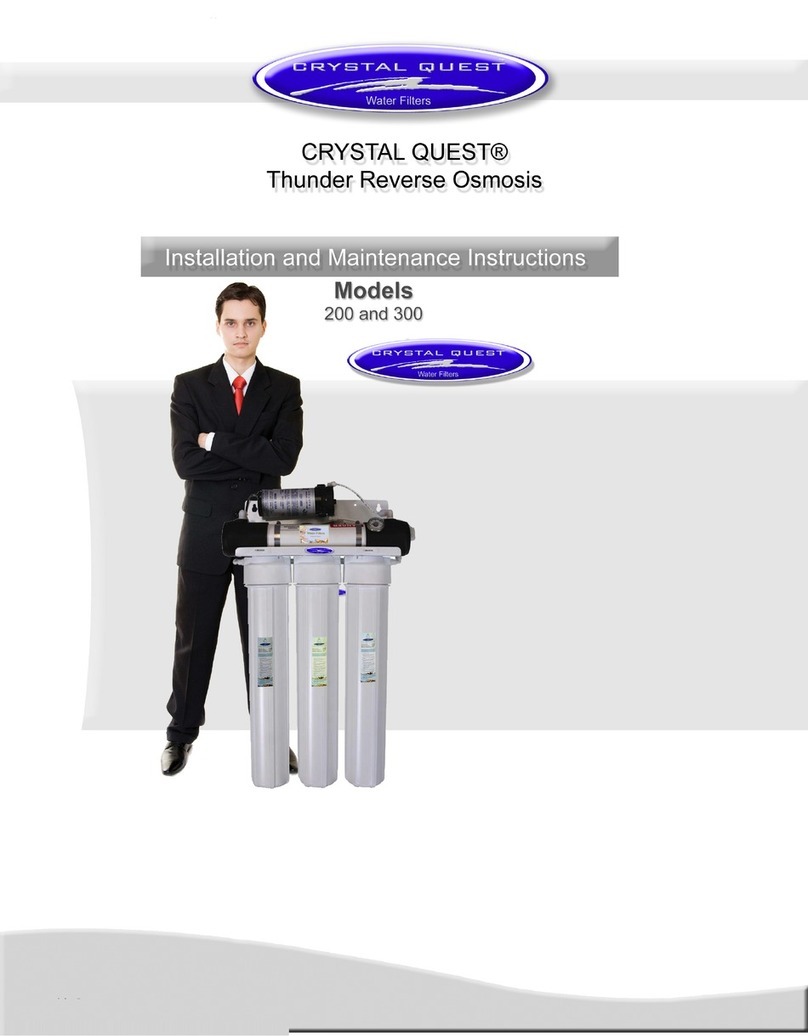
Crystal Quest
Crystal Quest 200 User manual

Crystal Quest
Crystal Quest 5600 Operating instructions
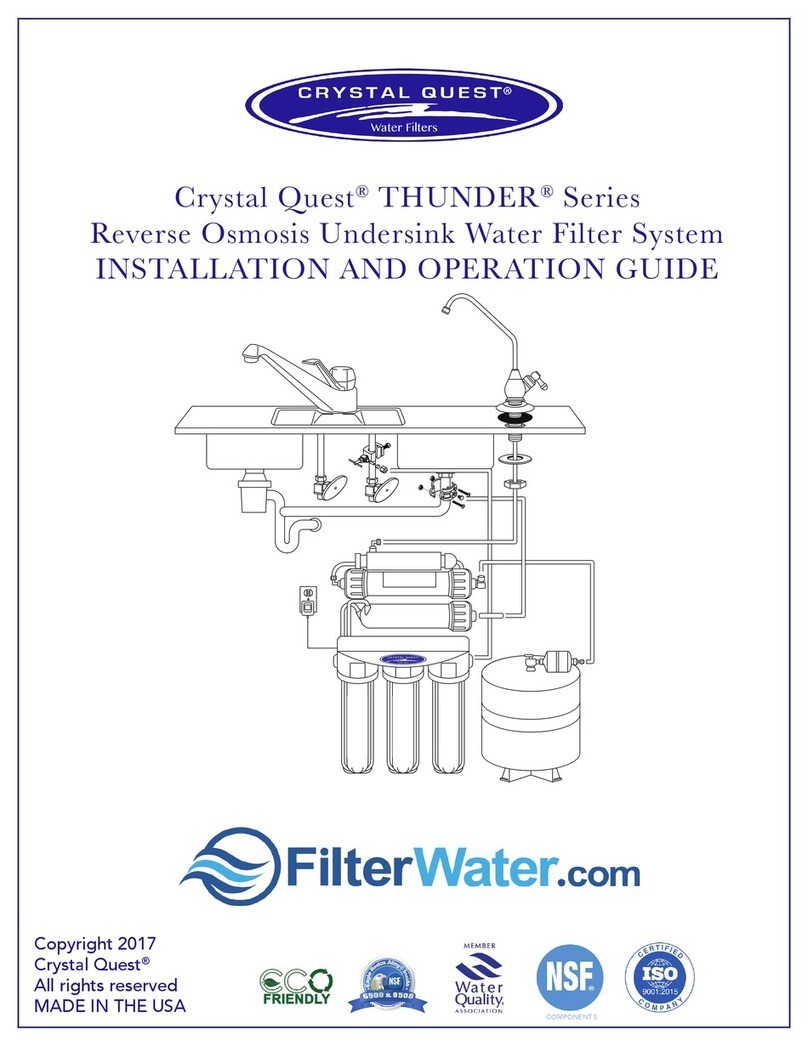
Crystal Quest
Crystal Quest 1,000 C Operating instructions
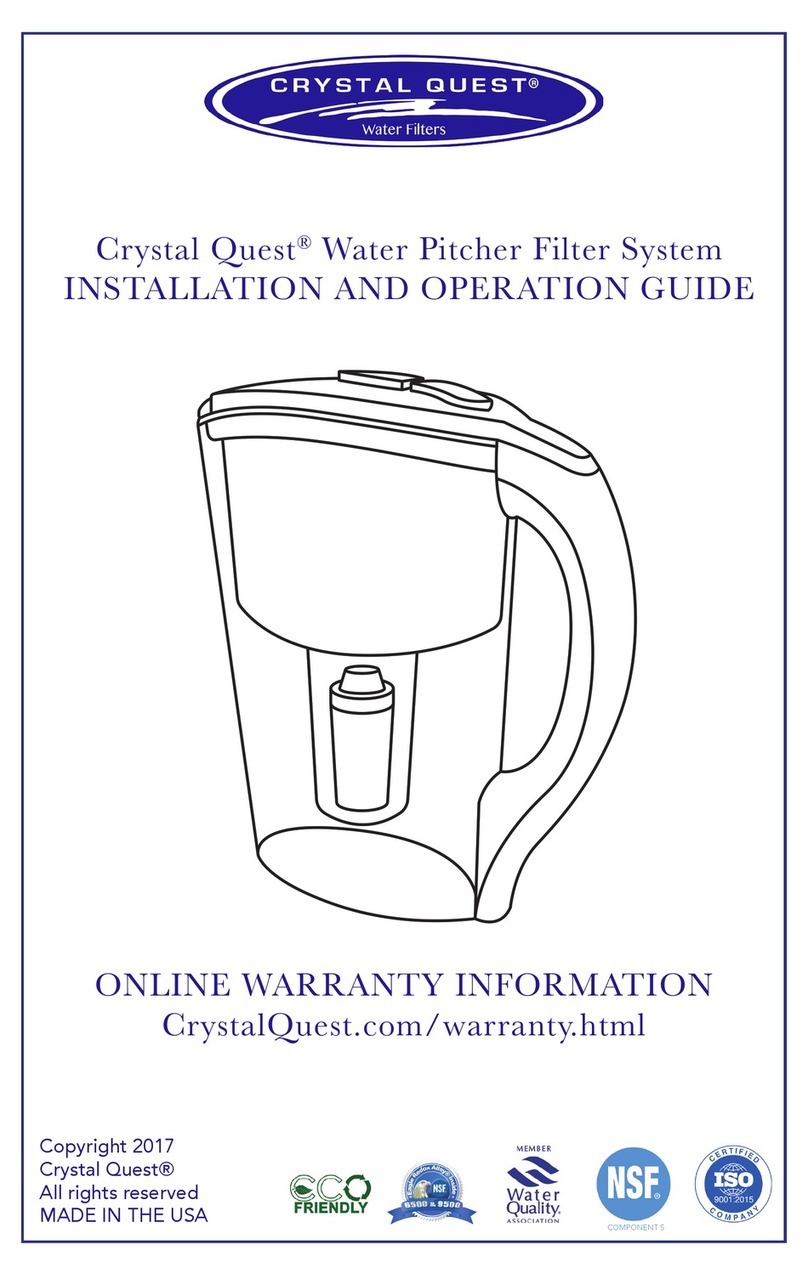
Crystal Quest
Crystal Quest CQE-PI-00601 Operating instructions
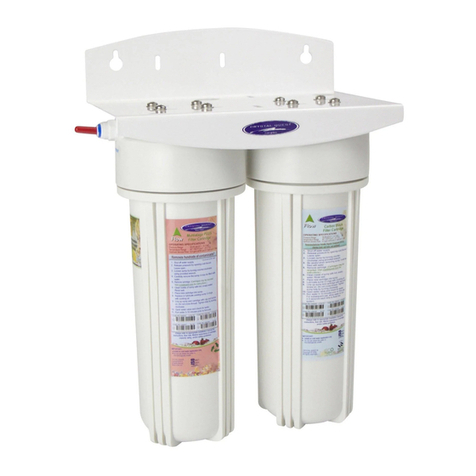
Crystal Quest
Crystal Quest Voyager Series Operating instructions
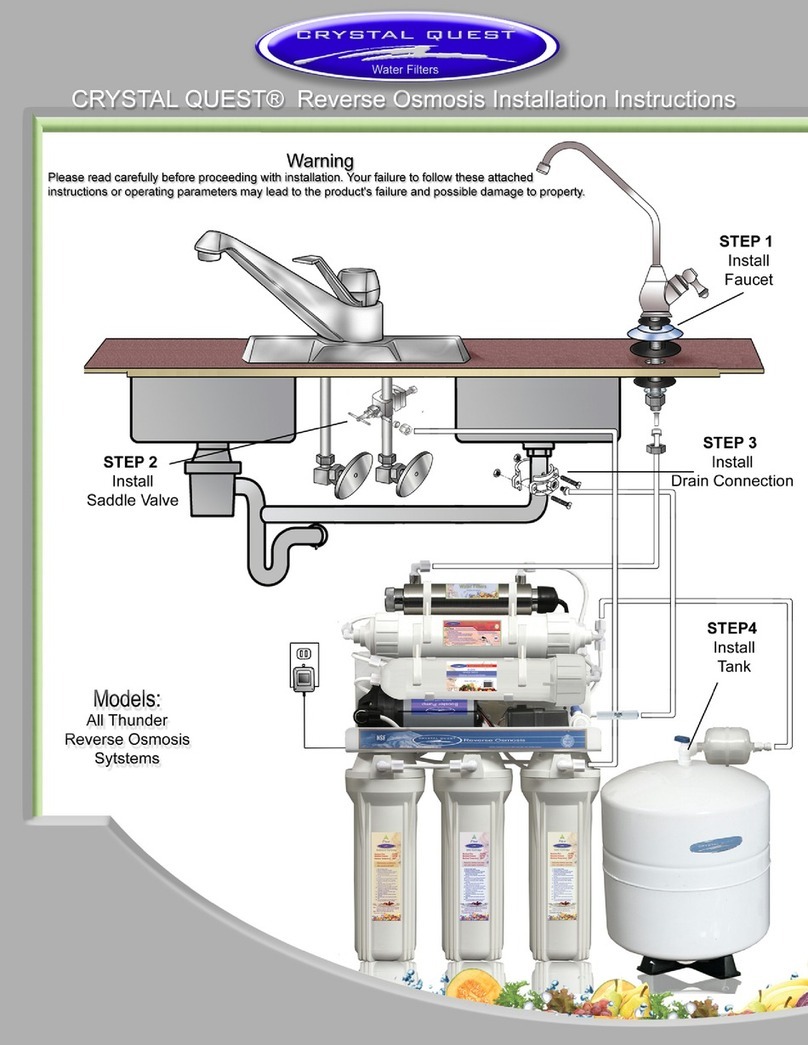
Crystal Quest
Crystal Quest Thunder Series User manual
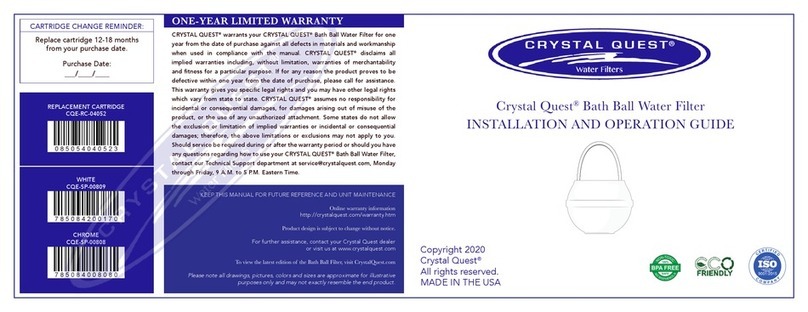
Crystal Quest
Crystal Quest CQE-SP-00809 Operating instructions
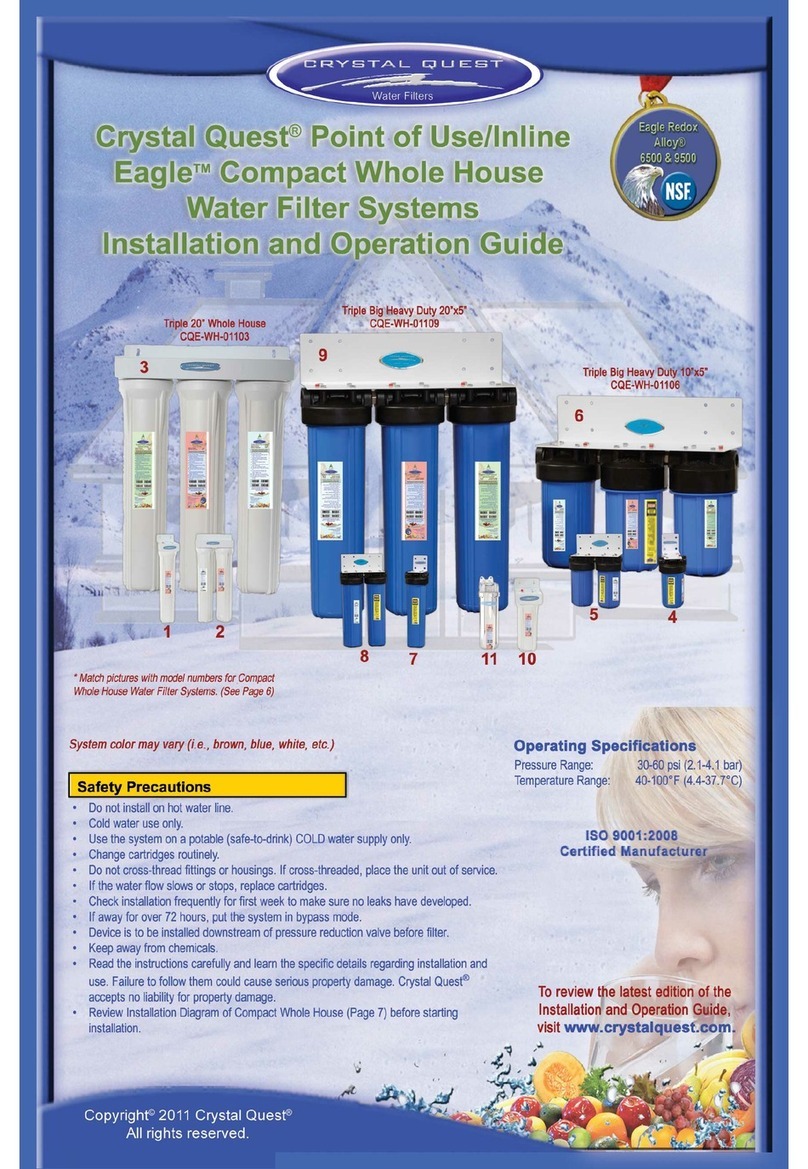
Crystal Quest
Crystal Quest CQE-WH-01103 Operating instructions
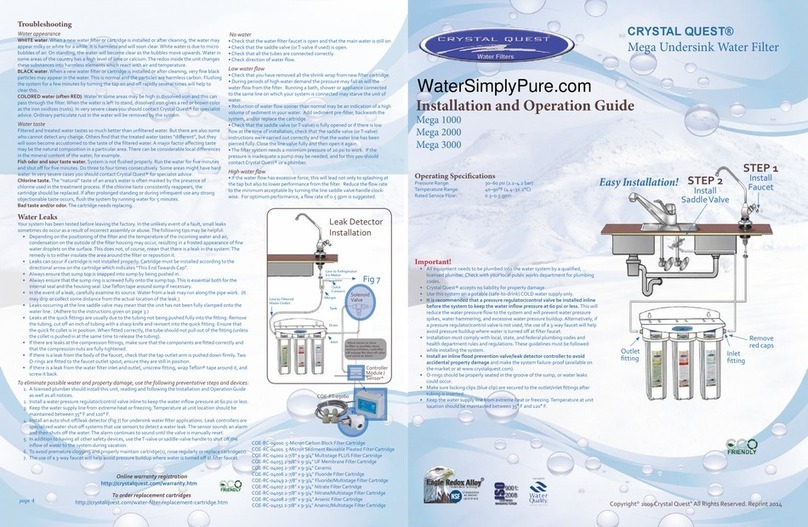
Crystal Quest
Crystal Quest Mega 1000 Operating instructions
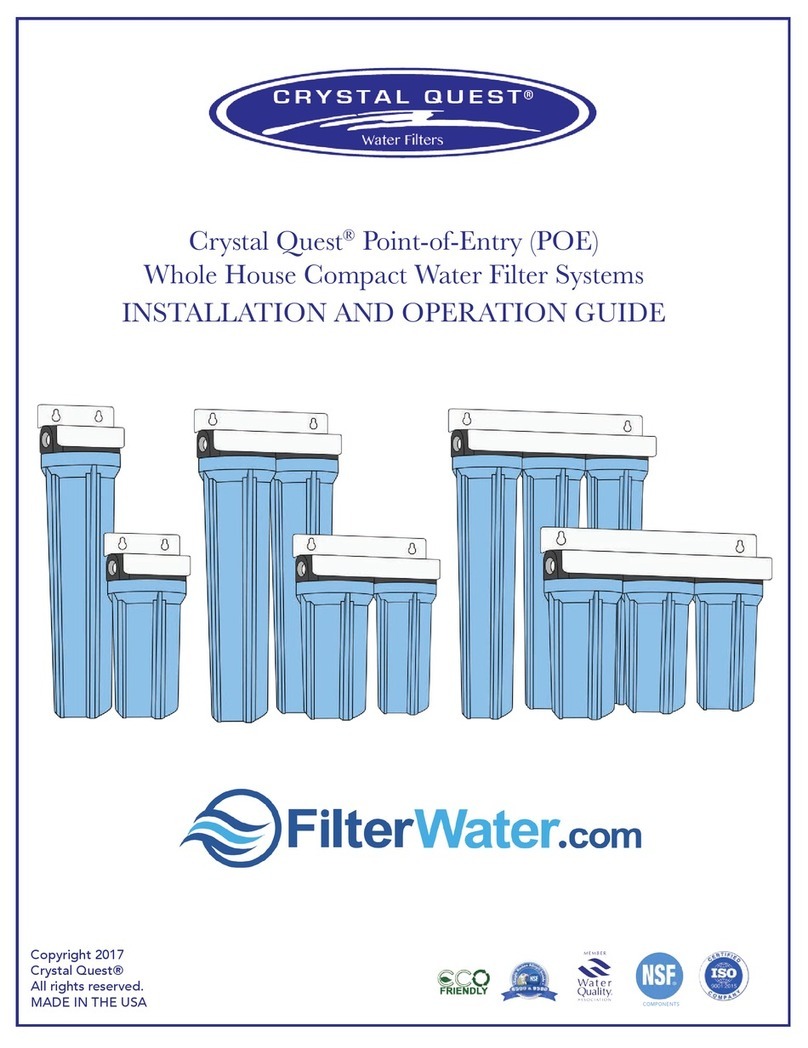
Crystal Quest
Crystal Quest CQE-WH-01101 Operating instructions

